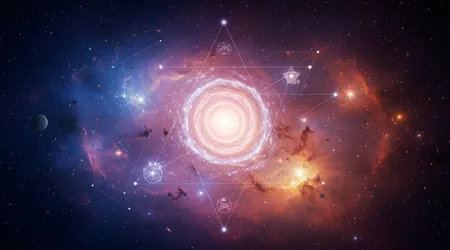How Many Dimensions Could Exist in the Universe?

How many dimensions could exist in the universe? This question has haunted physicists and philosophers alike, igniting debates that stretch across disciplines.
Anúncios
From the three-dimensional world we perceive to speculative realms beyond our senses, the concept of dimensions shapes our understanding of reality.
This exploration dives into the science, philosophy, and cutting-edge theories surrounding the universe’s dimensional structure.
We’ll unravel what dimensions mean, why they matter, and how modern research is pushing the boundaries of what we believe is possible.
Buckle up for a journey through space, time, and beyond, where the familiar meets the unimaginable.
Dimensions aren’t just a sci-fi trope; they’re fundamental to how we model the cosmos. Our everyday experience is rooted in three spatial dimensions length, width, height plus time as the fourth.
But could there be more? This article will weave together physics, mathematics, and philosophical inquiry to address how many dimensions could exist in the universe?
We’ll explore string theory’s bold claims, the role of quantum mechanics, and what experiments like those at CERN might reveal.
Along the way, we’ll tackle why this question matters and how it reshapes our view of existence.
What Are Dimensions, Anyway?
Dimensions define the framework of reality. Think of them as the coordinates needed to pinpoint an event. We live in three spatial dimensions.
Moving left-right, up-down, or forward-backward covers our physical world. Time adds a fourth dimension, guiding causality.
But how many dimensions could exist in the universe? Scientists speculate about “extra” dimensions beyond our perception that could fundamentally alter physics.
Consider a flat, two-dimensional world, like a sheet of paper. A being there couldn’t imagine “up.” Similarly, we may be blind to higher dimensions.
These extra dimensions might be curled up, too tiny to detect, or stretched across cosmic scales.
String theory, a leading framework, suggests up to 11 dimensions. This isn’t fantasy it’s math modeling the universe’s behavior.
The concept challenges intuition. Imagine a straw: from afar, it’s one-dimensional; up close, it’s a curled-up surface. Extra dimensions could hide similarly.
++ The Concept of Nothingness in Science and Philosophy
They might explain mysteries like gravity’s weakness compared to other forces. Unraveling how many dimensions could exist in the universe? could unlock these cosmic puzzles.
Physics thrives on such questions. Higher dimensions could bridge gaps in our understanding of black holes or dark energy.
They’re not just theoretical they’re testable, indirectly, through particle accelerators.
The Large Hadron Collider (LHC) searches for signs of extra dimensions by studying particle collisions. No direct evidence exists yet, but the hunt continues.

String Theory and the Case for 11 Dimensions
String theory is a bold attempt to unify physics. It posits that tiny, vibrating “strings” form all matter and forces. But it demands extra dimensions.
Specifically, how many dimensions could exist in the universe? String theory’s answer: 10 or 11, depending on the model. These dimensions aren’t all “big” like our familiar three.
In 1995, physicist Edward Witten proposed M-theory, unifying various string theories. It requires 11 dimensions to work mathematically.
Also read: The Anthropic Principle: Why Does the Universe Seem Made for Us?
These extra dimensions are compactified curled into spaces smaller than atoms. Picture a garden hose: from a distance, it’s a line; up close, it’s a tube. This analogy hints at how dimensions hide.
Why 11? The math works. String theory predicts particle behaviors that align with observations, but only in higher-dimensional frameworks.
Critics argue it’s untestable, yet proponents point to its elegance. How many dimensions could exist in the universe? If string theory holds, 11 is a strong contender.
The theory also explains gravity’s quirks. In three dimensions, gravity is oddly weak. Extra dimensions could “dilute” it across unseen realms.
Experiments at CERN test this by searching for “graviton” particles escaping into these dimensions. No luck yet, but the search fuels innovation.
The philosophical implications are profound. If 11 dimensions exist, our perception of reality is incomplete. What else are we missing? This question drives both science and imagination, pushing us to rethink existence itself.
Quantum Mechanics and Dimensional Hints
Quantum mechanics adds another layer to the puzzle. It describes reality at the smallest scales, where rules defy intuition.
Could it hint at how many dimensions could exist in the universe? Quantum effects might reveal extra dimensions through unexpected particle behaviors.
For example, quantum entanglement where particles share properties across vast distances suggests a deeper structure to spacetime.
Some physicists propose that entanglement could arise from hidden dimensions. A 2014 study in Physical Review Letters found that quantum systems might mimic higher-dimensional behaviors, offering indirect clues.
Read more: The Simulation Hypothesis: Are We Living in a Computer Program?
Imagine a spider web. Tug one thread, and the whole web vibrates. Entangled particles might connect through unseen dimensional threads.
This isn’t proof, but it’s a tantalizing hint. How many dimensions could exist in the universe? Quantum mechanics keeps the question alive.
Experiments like those at the LHC probe these ideas. If particles behave as if “leaking” into extra dimensions, we’d have evidence.
So far, results align with three spatial dimensions, but anomalies could change everything. The quantum world thrives on such possibilities.
This intersection of quantum mechanics and dimensions isn’t just academic. It could reshape technology, from quantum computing to energy production.
Exploring how many dimensions could exist in the universe? isn’t just curiosity it’s a gateway to innovation.
Philosophical Implications of Extra Dimensions
Beyond physics, dimensions challenge our understanding of reality. If extra dimensions exist, what does that mean for free will or consciousness?
Philosophers ponder whether how many dimensions could exist in the universe? shapes our place in the cosmos.
Consider a thought experiment: a being in a two-dimensional world can’t grasp “height.” Are we similarly limited? Extra dimensions might house phenomena we can’t conceive.
This humbles us, suggesting our reality is a sliver of a larger whole. It’s a philosophical wake-up call.
Some argue extra dimensions could explain metaphysical questions. Could consciousness tap into higher dimensions? No evidence supports this, but it sparks debate.
How many dimensions could exist in the universe? The question bridges science and existential inquiry.
Philosophers like Immanuel Kant viewed space as a human construct. Modern physics challenges this, suggesting dimensions are real, independent structures.
This shift reframes our understanding of existence, urging us to question what “real” means.
Experimental Evidence and Future Prospects
Can we prove extra dimensions? The LHC at CERN is our best bet. It smashes particles to detect anomalies hinting at higher dimensions.
No direct evidence exists as of 2025, but the search continues. How many dimensions could exist in the universe? Experiments hold the key.
A 2020 CERN study set constraints on extra dimensions, ruling out certain models. Here’s a table summarizing key findings:
| Experiment | Year | Finding | Implication |
|---|---|---|---|
| ATLAS (LHC) | 2020 | No graviton signals | Extra dimensions, if they exist, are smaller than 10^-19 meters |
This doesn’t disprove extra dimensions it narrows their possible size. Future upgrades to the LHC could detect subtler signs.
How many dimensions could exist in the universe? Patience might yield answers.
Other approaches include cosmic microwave background studies. Tiny fluctuations in this radiation could reveal dimensional effects.
Space telescopes like the James Webb are also probing these questions indirectly. The future is bright for discovery.
Imagine a cosmic detective story. Each experiment is a clue, building toward a revelation. Will we find extra dimensions?
The question keeps scientists awake at night, and it’s why the pursuit matters.
Why Dimensions Matter to Us

Why should you care about how many dimensions could exist in the universe? It’s not just academic—it reshapes our worldview.
Extra dimensions could explain cosmic mysteries, from dark matter to the universe’s expansion. They might even unlock new technologies.
For instance, if extra dimensions exist, they could inspire breakthroughs in energy or computing. String theory’s math already influences cryptography.
The practical stakes are high, even if the concepts feel abstract. Dimensions aren’t just theory they’re potential.
Philosophically, extra dimensions challenge our ego. If reality is vaster than we perceive, what else are we missing?
This question invites humility and curiosity. It’s a call to explore, to push beyond the known.
Finally, dimensions connect us to the cosmos. They remind us we’re part of a grand puzzle. Solving how many dimensions could exist in the universe?
is a human quest for truth, uniting science and wonder.
Conclusion: The Dimensional Frontier
The question of how many dimensions could exist in the universe? is more than a scientific riddle it’s a gateway to understanding existence.
From string theory’s 11 dimensions to quantum hints and philosophical musings, this exploration reveals a universe far richer than our senses suggest.
As experiments like those at CERN push forward, we stand on the brink of potentially transformative discoveries. Will we uncover hidden dimensions? Only time and rigorous science will tell.
This journey challenges us to think bigger. Like explorers charting unknown lands, we’re mapping reality’s edges.
The quest for extra dimensions isn’t just about physics; it’s about who we are and what’s possible. So, what’s next? Stay curious, because the universe is full of surprises waiting to be uncovered.
Frequently Asked Questions
Q: How do scientists test for extra dimensions?
A: They use particle accelerators like the LHC to detect anomalies, such as “missing” energy suggesting particles escaping into hidden dimensions.
Q: Could extra dimensions affect daily life?
A: Indirectly, yes. Discovering them could lead to new technologies, like advanced computing or energy systems, though direct impacts remain speculative.
